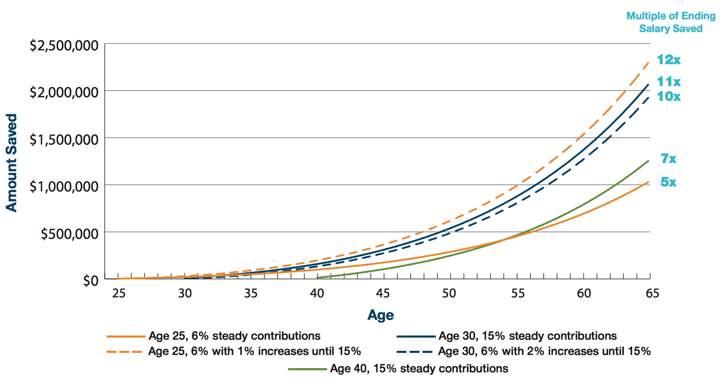 T. Rowe Price has a brochure The Benefit of Saving Regularly For Retirement [pdf] which has the common advice that you target saving at least 15% of your gross income each year to prepare for retirement. Of course, the earlier you start, the better. The added wrinkle here is that they offer an alternative route if you find 15% a stretch when you are young.
T. Rowe Price has a brochure The Benefit of Saving Regularly For Retirement [pdf] which has the common advice that you target saving at least 15% of your gross income each year to prepare for retirement. Of course, the earlier you start, the better. The added wrinkle here is that they offer an alternative route if you find 15% a stretch when you are young.

In their simulation, if you start saving at age 25 at a 6% rate and increase it 1% each year until you reach 15% (and then stay at 15%), you’ll actually come out ahead of someone who starts saving at age 30 at a 15% rate. You’ll even do okay if you start at age 30 at a 6% savings rate and increase it 2% a year until your reach 15% (and then stay at 15%). The two big takeaways are (1} start, even if small and (2) bump up your savings even if just a little by banking some of your raises each year.
The assumptions made seemed largely reasonable:
Examples beginning at age 25 assume a beginning salary of $40,000 escalated 5% a year to age 45 then 3% a year to age 65. Examples beginning at age 30 assume a beginning salary of $50,000 escalated 5% a year to age 45 then 3% a year to age 65. Example beginning at age 40 assumes a beginning salary of $80,000 escalated 5% a year to age 45 then 3% a year to age 65. Annual rate of return is 7%. All savings are assumed tax-deferred. Multiple of ending salary saved divides final ending portfolio balance by ending salary at age 65.
Bottom line. Start saving regularly, no matter the amount. Even if you feel like you can’t save 10% or 20% or whatever you read somewhere, just should start as soon as possible with a smaller number. After a year, try to increase your savings rate by 1% or 2%. Repeat each year. This can help minimize how much you “feel” the savings, while still ending up with a healthy nest egg. Build the habit.
 The Best Credit Card Bonus Offers – 2025
The Best Credit Card Bonus Offers – 2025 Big List of Free Stocks from Brokerage Apps
Big List of Free Stocks from Brokerage Apps Best Interest Rates on Cash - 2025
Best Interest Rates on Cash - 2025 Free Credit Scores x 3 + Free Credit Monitoring
Free Credit Scores x 3 + Free Credit Monitoring Best No Fee 0% APR Balance Transfer Offers
Best No Fee 0% APR Balance Transfer Offers Little-Known Cellular Data Plans That Can Save Big Money
Little-Known Cellular Data Plans That Can Save Big Money How To Haggle Your Cable or Direct TV Bill
How To Haggle Your Cable or Direct TV Bill Big List of Free Consumer Data Reports (Credit, Rent, Work)
Big List of Free Consumer Data Reports (Credit, Rent, Work)
Hi Jonathan….off topic but I wasn’t sure how to contact you.
Just came across this Auto Parts Class Action Suit. I know you sometimes publish these.
I though you might be interested
https://www.autopartsclass.com/
Thanks for the tip, I will check it out. You can also contact me here:
https://www.mymoneyblog.com/contact-me/
Question: What is the assumed starting salary and is there a yearly increase in that salary? Trying to spread the retirement love to the younger generation. Thanks!
Here are all of their assumptions:
Geez. This ends up with a $192k salary at age 65.
That probably won’t seem like as much 40 years from now, in the year 2058. Inflation will eat up a lot of those increases.
Look 40 years back. Median household income was about $14,000 in 1978.
In SF $117,400 a year or less is the threshold for “low income” now. “Very low income” is considered under $73,300. Based on the assumptions above anyone starting out in SF at those wages would be low income for life. All the sudden that $192K at age 65 is looking rather meek.
Many years ago, I read the advice somewhere to save half of every raise you get. I found that it’s been great advice to help reach savings goals just like this article promotes.
I remember that when I left my first job, I barely had anything saved for retirement. I made an entry level salary and put only a couple percent into it. I didn’t roll it over so they ended up sending me a check. The guy that did my taxes asked me about it and got really upset with me when I told him what I’d done. He made sure I understood that the amount wasn’t the issue, it was that you have to start as soon as you can to get into the habit of saving for retirement. That has stuck with me ever since.
Twenty years ago in my late Thirties, I could only cobble up $50 to get me started in a T Rowe Price fund. Earlier I put $2000 in a traditional IRA through T Rowe Price in the New Asia fund. The $50 initial contribution was a great deal. I eventually put a total of $4000 in that IRA and it’s worth over $19000 today.